CHCYTH010: Responding to Young People's Needs Through Case Studies
VerifiedAdded on 2023/06/10
|10
|2499
|487
Case Study
AI Summary
This assignment presents case studies of two young individuals, Ivy and Max, highlighting the challenges they face, including sexual abuse, drug addiction, and family issues. It discusses goal setting and appropriate referrals to social services, psychiatric support, and rehabilitation programs. The assignment emphasizes the importance of advocacy for young people, ensuring their rights to protection, education, and healthcare are met, in accordance with relevant child protection acts. It also underscores the significance of emotional support, family counseling, and peer interaction in addressing the psychological and social needs of young people facing adversity. The assignment emphasizes the need for self-reflection, positive contributions to their surroundings, and engagement with support groups to facilitate recovery and personal growth.
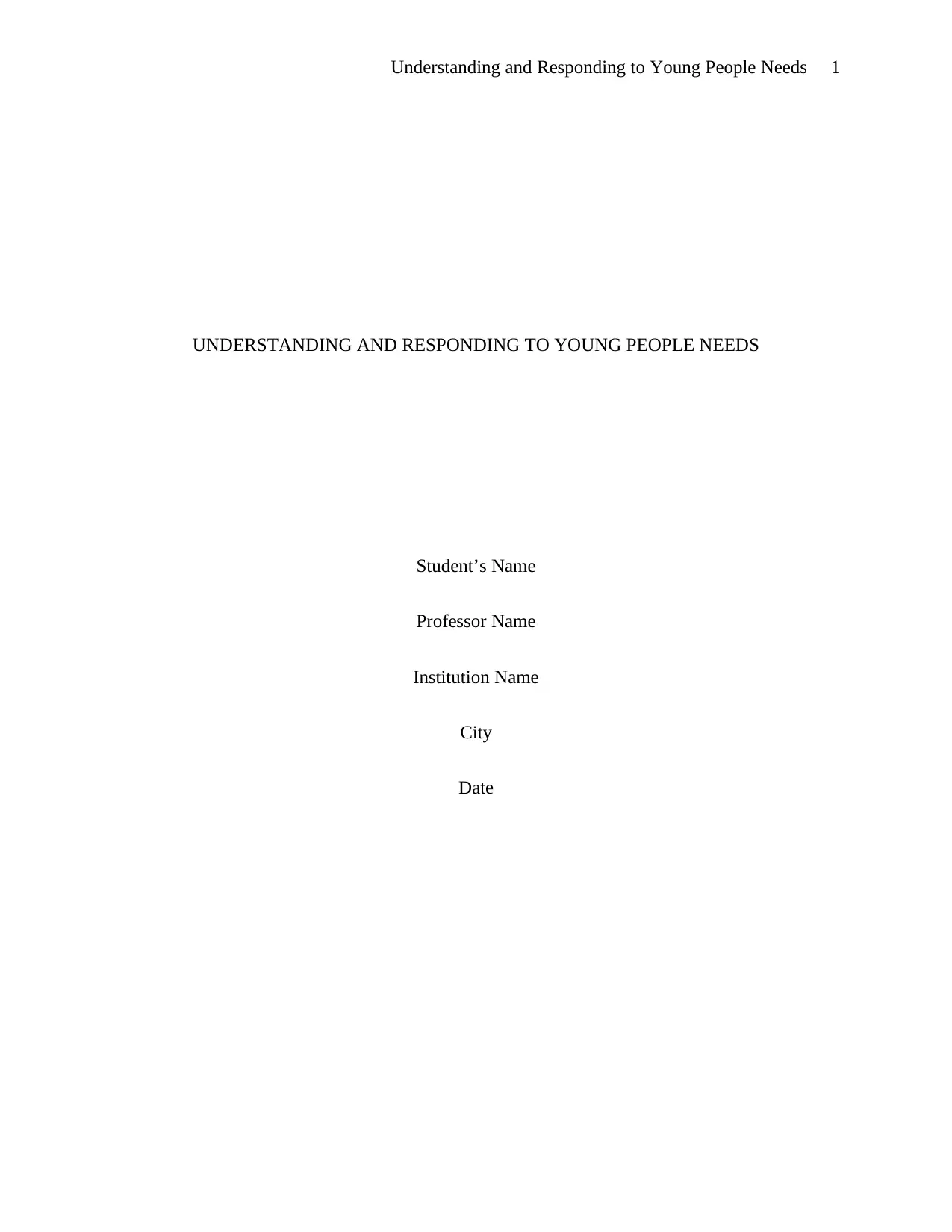
Understanding and Responding to Young People Needs 1
UNDERSTANDING AND RESPONDING TO YOUNG PEOPLE NEEDS
Student’s Name
Professor Name
Institution Name
City
Date
UNDERSTANDING AND RESPONDING TO YOUNG PEOPLE NEEDS
Student’s Name
Professor Name
Institution Name
City
Date
Secure Best Marks with AI Grader
Need help grading? Try our AI Grader for instant feedback on your assignments.
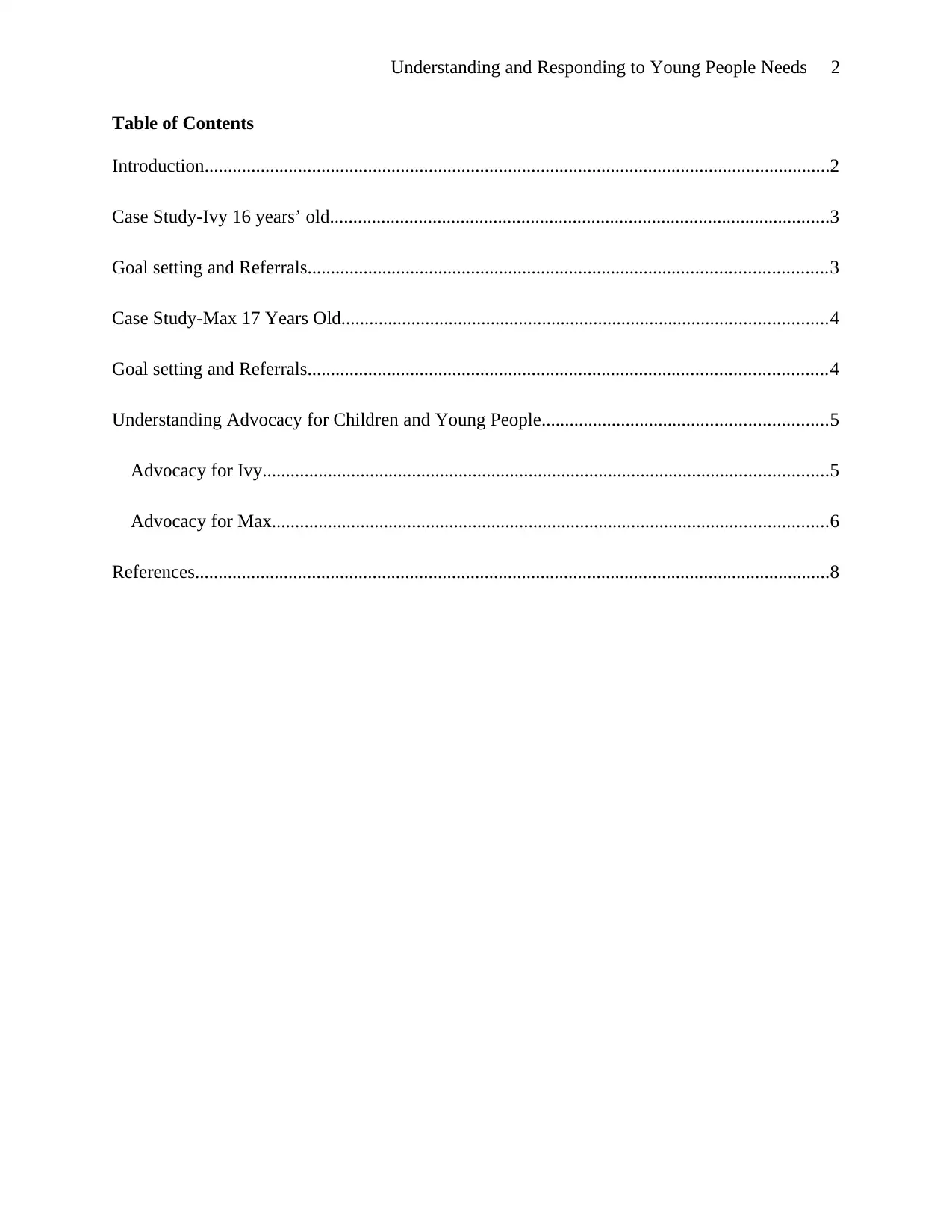
Understanding and Responding to Young People Needs 2
Table of Contents
Introduction......................................................................................................................................2
Case Study-Ivy 16 years’ old...........................................................................................................3
Goal setting and Referrals...............................................................................................................3
Case Study-Max 17 Years Old........................................................................................................4
Goal setting and Referrals...............................................................................................................4
Understanding Advocacy for Children and Young People.............................................................5
Advocacy for Ivy.........................................................................................................................5
Advocacy for Max.......................................................................................................................6
References........................................................................................................................................8
Table of Contents
Introduction......................................................................................................................................2
Case Study-Ivy 16 years’ old...........................................................................................................3
Goal setting and Referrals...............................................................................................................3
Case Study-Max 17 Years Old........................................................................................................4
Goal setting and Referrals...............................................................................................................4
Understanding Advocacy for Children and Young People.............................................................5
Advocacy for Ivy.........................................................................................................................5
Advocacy for Max.......................................................................................................................6
References........................................................................................................................................8
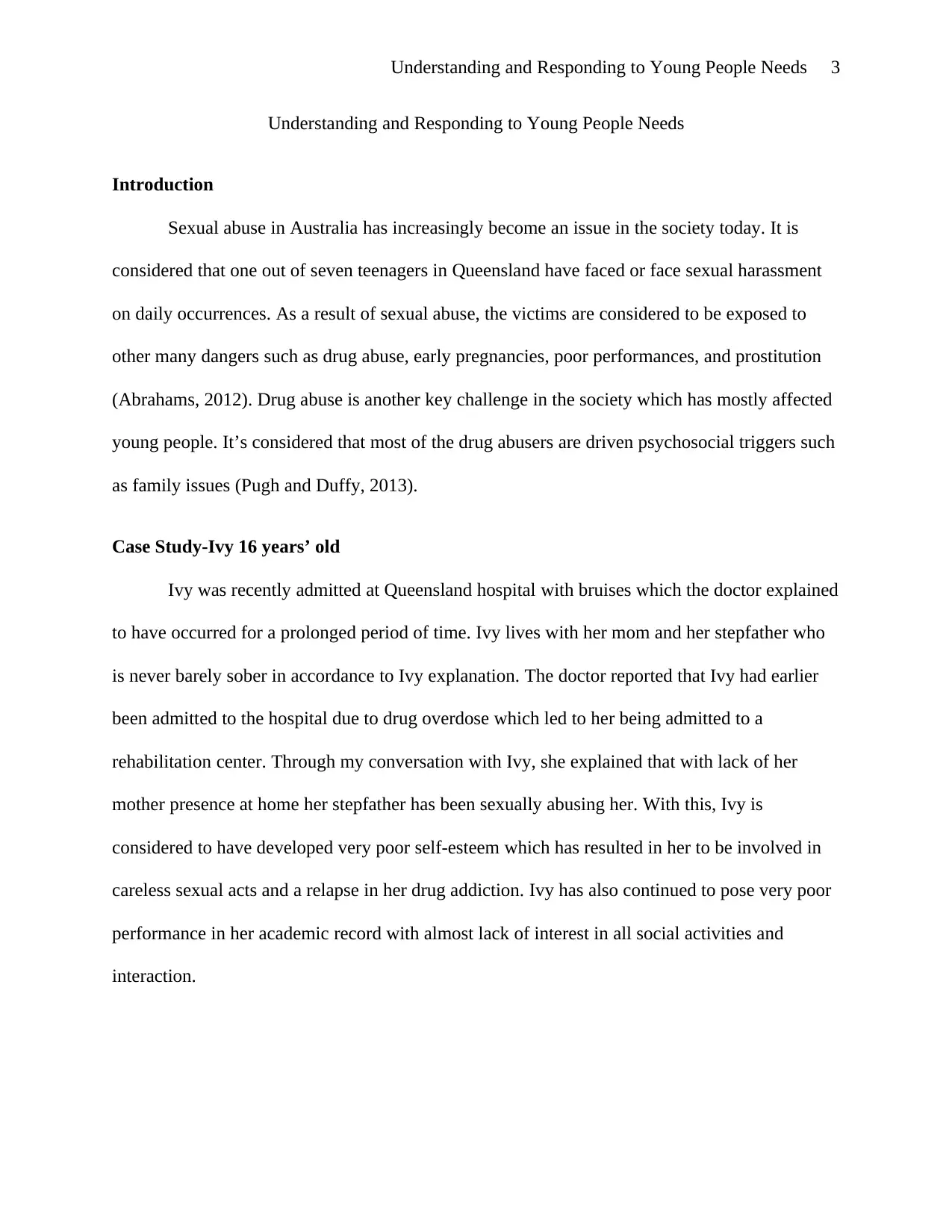
Understanding and Responding to Young People Needs 3
Understanding and Responding to Young People Needs
Introduction
Sexual abuse in Australia has increasingly become an issue in the society today. It is
considered that one out of seven teenagers in Queensland have faced or face sexual harassment
on daily occurrences. As a result of sexual abuse, the victims are considered to be exposed to
other many dangers such as drug abuse, early pregnancies, poor performances, and prostitution
(Abrahams, 2012). Drug abuse is another key challenge in the society which has mostly affected
young people. It’s considered that most of the drug abusers are driven psychosocial triggers such
as family issues (Pugh and Duffy, 2013).
Case Study-Ivy 16 years’ old
Ivy was recently admitted at Queensland hospital with bruises which the doctor explained
to have occurred for a prolonged period of time. Ivy lives with her mom and her stepfather who
is never barely sober in accordance to Ivy explanation. The doctor reported that Ivy had earlier
been admitted to the hospital due to drug overdose which led to her being admitted to a
rehabilitation center. Through my conversation with Ivy, she explained that with lack of her
mother presence at home her stepfather has been sexually abusing her. With this, Ivy is
considered to have developed very poor self-esteem which has resulted in her to be involved in
careless sexual acts and a relapse in her drug addiction. Ivy has also continued to pose very poor
performance in her academic record with almost lack of interest in all social activities and
interaction.
Understanding and Responding to Young People Needs
Introduction
Sexual abuse in Australia has increasingly become an issue in the society today. It is
considered that one out of seven teenagers in Queensland have faced or face sexual harassment
on daily occurrences. As a result of sexual abuse, the victims are considered to be exposed to
other many dangers such as drug abuse, early pregnancies, poor performances, and prostitution
(Abrahams, 2012). Drug abuse is another key challenge in the society which has mostly affected
young people. It’s considered that most of the drug abusers are driven psychosocial triggers such
as family issues (Pugh and Duffy, 2013).
Case Study-Ivy 16 years’ old
Ivy was recently admitted at Queensland hospital with bruises which the doctor explained
to have occurred for a prolonged period of time. Ivy lives with her mom and her stepfather who
is never barely sober in accordance to Ivy explanation. The doctor reported that Ivy had earlier
been admitted to the hospital due to drug overdose which led to her being admitted to a
rehabilitation center. Through my conversation with Ivy, she explained that with lack of her
mother presence at home her stepfather has been sexually abusing her. With this, Ivy is
considered to have developed very poor self-esteem which has resulted in her to be involved in
careless sexual acts and a relapse in her drug addiction. Ivy has also continued to pose very poor
performance in her academic record with almost lack of interest in all social activities and
interaction.
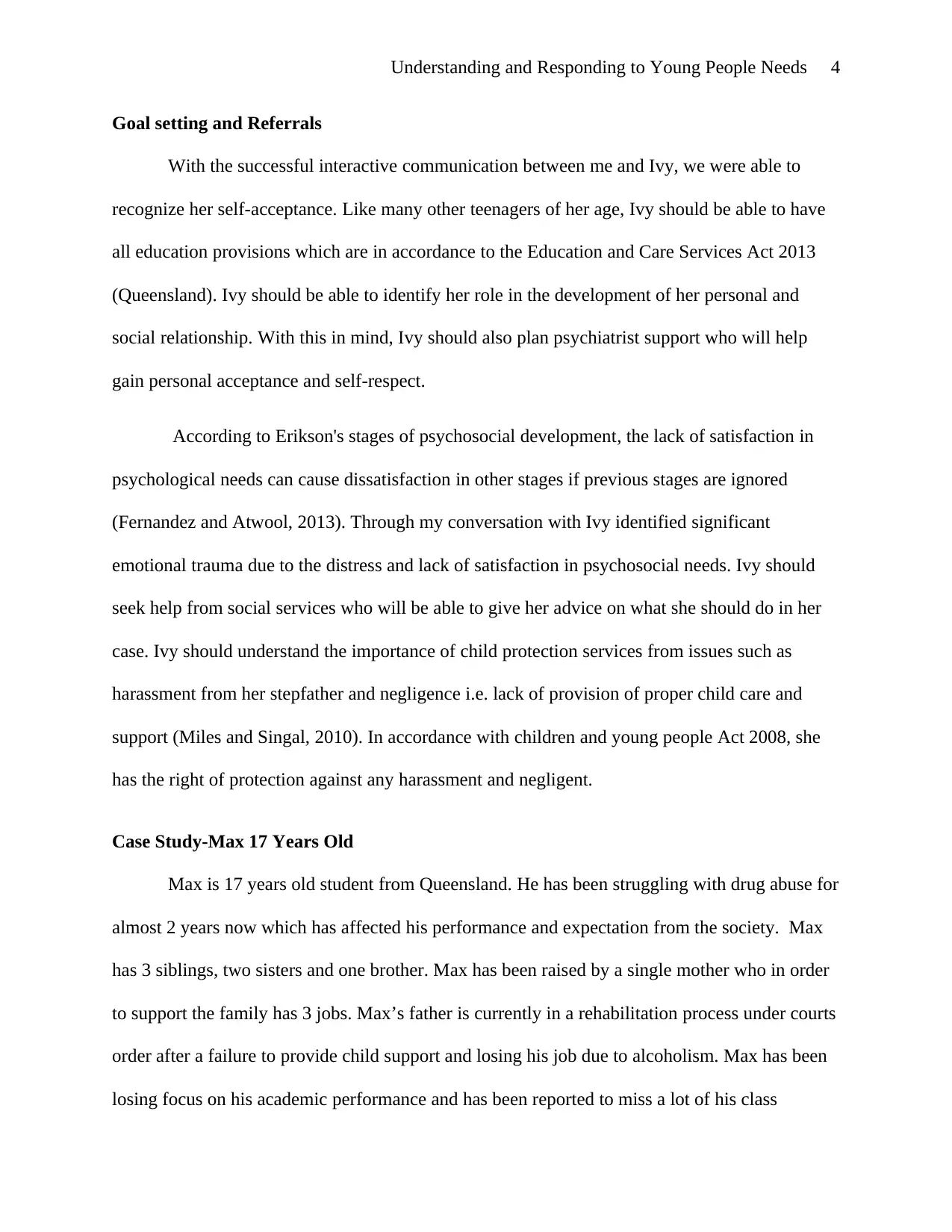
Understanding and Responding to Young People Needs 4
Goal setting and Referrals
With the successful interactive communication between me and Ivy, we were able to
recognize her self-acceptance. Like many other teenagers of her age, Ivy should be able to have
all education provisions which are in accordance to the Education and Care Services Act 2013
(Queensland). Ivy should be able to identify her role in the development of her personal and
social relationship. With this in mind, Ivy should also plan psychiatrist support who will help
gain personal acceptance and self-respect.
According to Erikson's stages of psychosocial development, the lack of satisfaction in
psychological needs can cause dissatisfaction in other stages if previous stages are ignored
(Fernandez and Atwool, 2013). Through my conversation with Ivy identified significant
emotional trauma due to the distress and lack of satisfaction in psychosocial needs. Ivy should
seek help from social services who will be able to give her advice on what she should do in her
case. Ivy should understand the importance of child protection services from issues such as
harassment from her stepfather and negligence i.e. lack of provision of proper child care and
support (Miles and Singal, 2010). In accordance with children and young people Act 2008, she
has the right of protection against any harassment and negligent.
Case Study-Max 17 Years Old
Max is 17 years old student from Queensland. He has been struggling with drug abuse for
almost 2 years now which has affected his performance and expectation from the society. Max
has 3 siblings, two sisters and one brother. Max has been raised by a single mother who in order
to support the family has 3 jobs. Max’s father is currently in a rehabilitation process under courts
order after a failure to provide child support and losing his job due to alcoholism. Max has been
losing focus on his academic performance and has been reported to miss a lot of his class
Goal setting and Referrals
With the successful interactive communication between me and Ivy, we were able to
recognize her self-acceptance. Like many other teenagers of her age, Ivy should be able to have
all education provisions which are in accordance to the Education and Care Services Act 2013
(Queensland). Ivy should be able to identify her role in the development of her personal and
social relationship. With this in mind, Ivy should also plan psychiatrist support who will help
gain personal acceptance and self-respect.
According to Erikson's stages of psychosocial development, the lack of satisfaction in
psychological needs can cause dissatisfaction in other stages if previous stages are ignored
(Fernandez and Atwool, 2013). Through my conversation with Ivy identified significant
emotional trauma due to the distress and lack of satisfaction in psychosocial needs. Ivy should
seek help from social services who will be able to give her advice on what she should do in her
case. Ivy should understand the importance of child protection services from issues such as
harassment from her stepfather and negligence i.e. lack of provision of proper child care and
support (Miles and Singal, 2010). In accordance with children and young people Act 2008, she
has the right of protection against any harassment and negligent.
Case Study-Max 17 Years Old
Max is 17 years old student from Queensland. He has been struggling with drug abuse for
almost 2 years now which has affected his performance and expectation from the society. Max
has 3 siblings, two sisters and one brother. Max has been raised by a single mother who in order
to support the family has 3 jobs. Max’s father is currently in a rehabilitation process under courts
order after a failure to provide child support and losing his job due to alcoholism. Max has been
losing focus on his academic performance and has been reported to miss a lot of his class
Secure Best Marks with AI Grader
Need help grading? Try our AI Grader for instant feedback on your assignments.
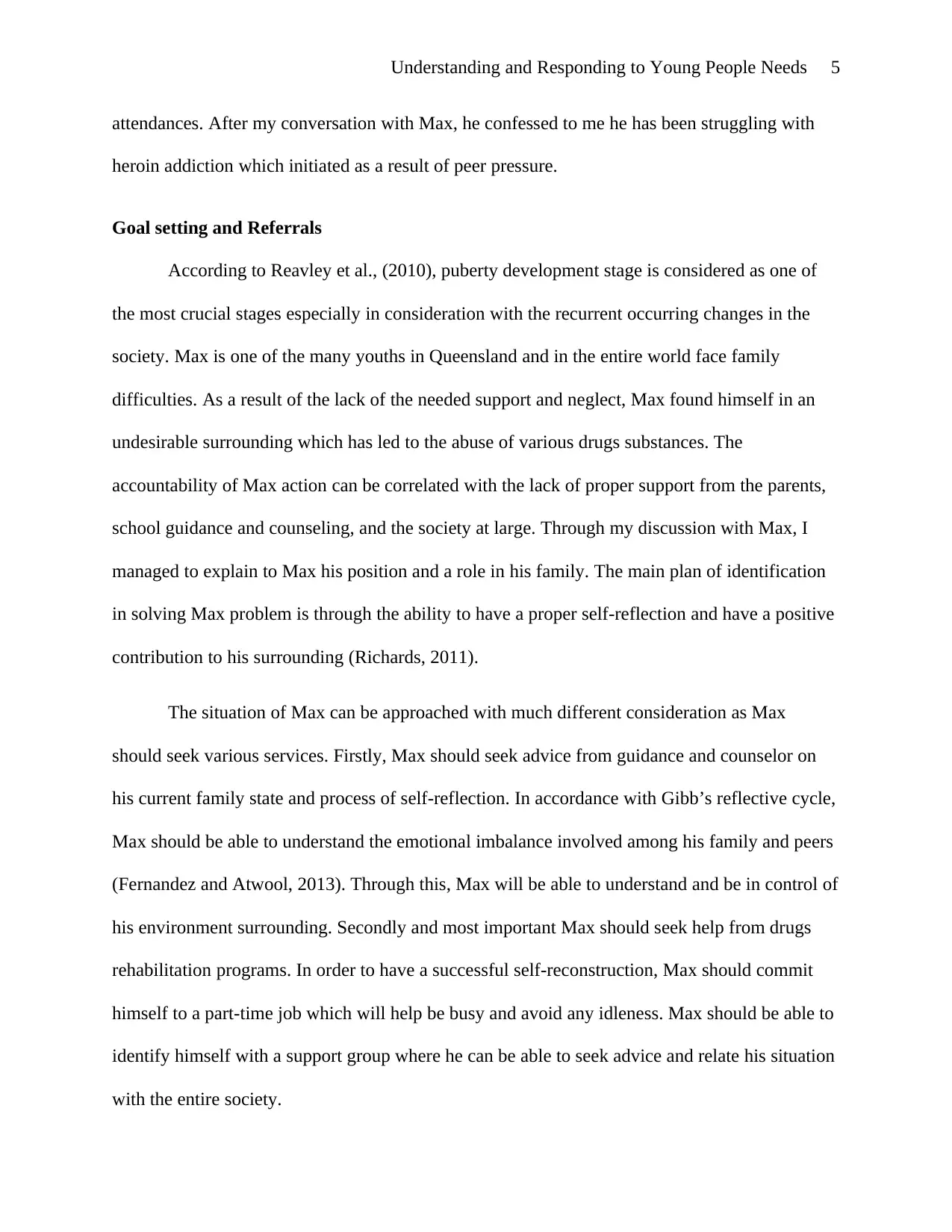
Understanding and Responding to Young People Needs 5
attendances. After my conversation with Max, he confessed to me he has been struggling with
heroin addiction which initiated as a result of peer pressure.
Goal setting and Referrals
According to Reavley et al., (2010), puberty development stage is considered as one of
the most crucial stages especially in consideration with the recurrent occurring changes in the
society. Max is one of the many youths in Queensland and in the entire world face family
difficulties. As a result of the lack of the needed support and neglect, Max found himself in an
undesirable surrounding which has led to the abuse of various drugs substances. The
accountability of Max action can be correlated with the lack of proper support from the parents,
school guidance and counseling, and the society at large. Through my discussion with Max, I
managed to explain to Max his position and a role in his family. The main plan of identification
in solving Max problem is through the ability to have a proper self-reflection and have a positive
contribution to his surrounding (Richards, 2011).
The situation of Max can be approached with much different consideration as Max
should seek various services. Firstly, Max should seek advice from guidance and counselor on
his current family state and process of self-reflection. In accordance with Gibb’s reflective cycle,
Max should be able to understand the emotional imbalance involved among his family and peers
(Fernandez and Atwool, 2013). Through this, Max will be able to understand and be in control of
his environment surrounding. Secondly and most important Max should seek help from drugs
rehabilitation programs. In order to have a successful self-reconstruction, Max should commit
himself to a part-time job which will help be busy and avoid any idleness. Max should be able to
identify himself with a support group where he can be able to seek advice and relate his situation
with the entire society.
attendances. After my conversation with Max, he confessed to me he has been struggling with
heroin addiction which initiated as a result of peer pressure.
Goal setting and Referrals
According to Reavley et al., (2010), puberty development stage is considered as one of
the most crucial stages especially in consideration with the recurrent occurring changes in the
society. Max is one of the many youths in Queensland and in the entire world face family
difficulties. As a result of the lack of the needed support and neglect, Max found himself in an
undesirable surrounding which has led to the abuse of various drugs substances. The
accountability of Max action can be correlated with the lack of proper support from the parents,
school guidance and counseling, and the society at large. Through my discussion with Max, I
managed to explain to Max his position and a role in his family. The main plan of identification
in solving Max problem is through the ability to have a proper self-reflection and have a positive
contribution to his surrounding (Richards, 2011).
The situation of Max can be approached with much different consideration as Max
should seek various services. Firstly, Max should seek advice from guidance and counselor on
his current family state and process of self-reflection. In accordance with Gibb’s reflective cycle,
Max should be able to understand the emotional imbalance involved among his family and peers
(Fernandez and Atwool, 2013). Through this, Max will be able to understand and be in control of
his environment surrounding. Secondly and most important Max should seek help from drugs
rehabilitation programs. In order to have a successful self-reconstruction, Max should commit
himself to a part-time job which will help be busy and avoid any idleness. Max should be able to
identify himself with a support group where he can be able to seek advice and relate his situation
with the entire society.
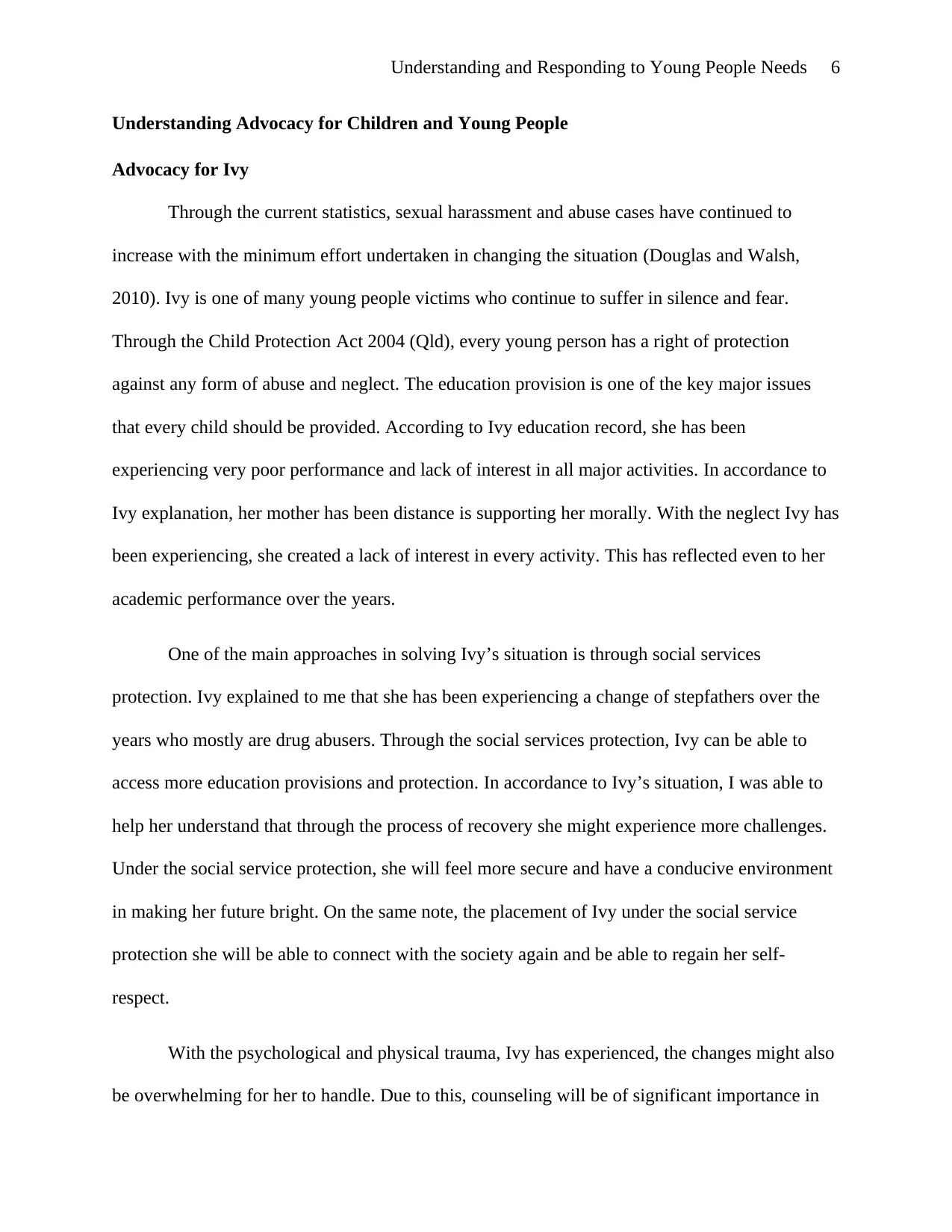
Understanding and Responding to Young People Needs 6
Understanding Advocacy for Children and Young People
Advocacy for Ivy
Through the current statistics, sexual harassment and abuse cases have continued to
increase with the minimum effort undertaken in changing the situation (Douglas and Walsh,
2010). Ivy is one of many young people victims who continue to suffer in silence and fear.
Through the Child Protection Act 2004 (Qld), every young person has a right of protection
against any form of abuse and neglect. The education provision is one of the key major issues
that every child should be provided. According to Ivy education record, she has been
experiencing very poor performance and lack of interest in all major activities. In accordance to
Ivy explanation, her mother has been distance is supporting her morally. With the neglect Ivy has
been experiencing, she created a lack of interest in every activity. This has reflected even to her
academic performance over the years.
One of the main approaches in solving Ivy’s situation is through social services
protection. Ivy explained to me that she has been experiencing a change of stepfathers over the
years who mostly are drug abusers. Through the social services protection, Ivy can be able to
access more education provisions and protection. In accordance to Ivy’s situation, I was able to
help her understand that through the process of recovery she might experience more challenges.
Under the social service protection, she will feel more secure and have a conducive environment
in making her future bright. On the same note, the placement of Ivy under the social service
protection she will be able to connect with the society again and be able to regain her self-
respect.
With the psychological and physical trauma, Ivy has experienced, the changes might also
be overwhelming for her to handle. Due to this, counseling will be of significant importance in
Understanding Advocacy for Children and Young People
Advocacy for Ivy
Through the current statistics, sexual harassment and abuse cases have continued to
increase with the minimum effort undertaken in changing the situation (Douglas and Walsh,
2010). Ivy is one of many young people victims who continue to suffer in silence and fear.
Through the Child Protection Act 2004 (Qld), every young person has a right of protection
against any form of abuse and neglect. The education provision is one of the key major issues
that every child should be provided. According to Ivy education record, she has been
experiencing very poor performance and lack of interest in all major activities. In accordance to
Ivy explanation, her mother has been distance is supporting her morally. With the neglect Ivy has
been experiencing, she created a lack of interest in every activity. This has reflected even to her
academic performance over the years.
One of the main approaches in solving Ivy’s situation is through social services
protection. Ivy explained to me that she has been experiencing a change of stepfathers over the
years who mostly are drug abusers. Through the social services protection, Ivy can be able to
access more education provisions and protection. In accordance to Ivy’s situation, I was able to
help her understand that through the process of recovery she might experience more challenges.
Under the social service protection, she will feel more secure and have a conducive environment
in making her future bright. On the same note, the placement of Ivy under the social service
protection she will be able to connect with the society again and be able to regain her self-
respect.
With the psychological and physical trauma, Ivy has experienced, the changes might also
be overwhelming for her to handle. Due to this, counseling will be of significant importance in
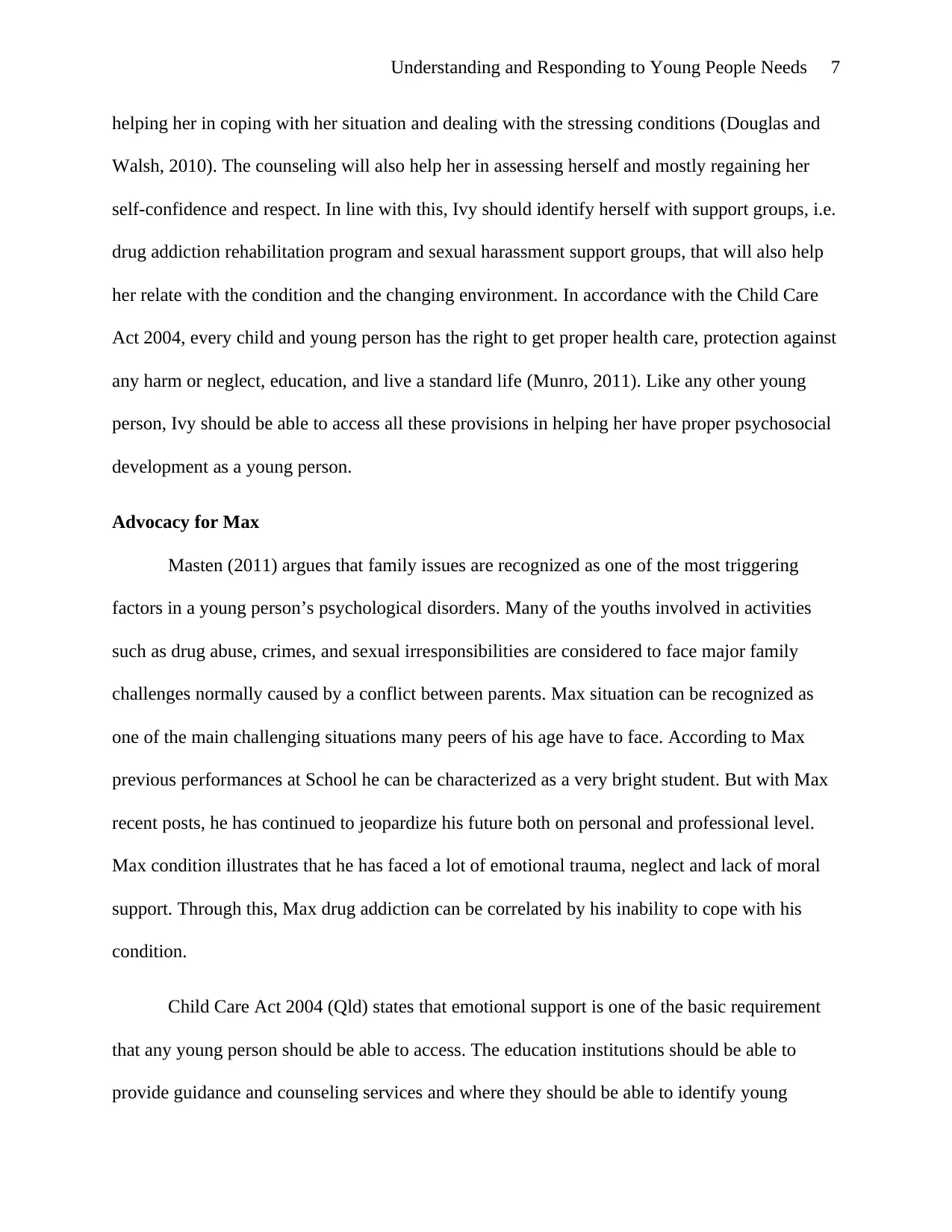
Understanding and Responding to Young People Needs 7
helping her in coping with her situation and dealing with the stressing conditions (Douglas and
Walsh, 2010). The counseling will also help her in assessing herself and mostly regaining her
self-confidence and respect. In line with this, Ivy should identify herself with support groups, i.e.
drug addiction rehabilitation program and sexual harassment support groups, that will also help
her relate with the condition and the changing environment. In accordance with the Child Care
Act 2004, every child and young person has the right to get proper health care, protection against
any harm or neglect, education, and live a standard life (Munro, 2011). Like any other young
person, Ivy should be able to access all these provisions in helping her have proper psychosocial
development as a young person.
Advocacy for Max
Masten (2011) argues that family issues are recognized as one of the most triggering
factors in a young person’s psychological disorders. Many of the youths involved in activities
such as drug abuse, crimes, and sexual irresponsibilities are considered to face major family
challenges normally caused by a conflict between parents. Max situation can be recognized as
one of the main challenging situations many peers of his age have to face. According to Max
previous performances at School he can be characterized as a very bright student. But with Max
recent posts, he has continued to jeopardize his future both on personal and professional level.
Max condition illustrates that he has faced a lot of emotional trauma, neglect and lack of moral
support. Through this, Max drug addiction can be correlated by his inability to cope with his
condition.
Child Care Act 2004 (Qld) states that emotional support is one of the basic requirement
that any young person should be able to access. The education institutions should be able to
provide guidance and counseling services and where they should be able to identify young
helping her in coping with her situation and dealing with the stressing conditions (Douglas and
Walsh, 2010). The counseling will also help her in assessing herself and mostly regaining her
self-confidence and respect. In line with this, Ivy should identify herself with support groups, i.e.
drug addiction rehabilitation program and sexual harassment support groups, that will also help
her relate with the condition and the changing environment. In accordance with the Child Care
Act 2004, every child and young person has the right to get proper health care, protection against
any harm or neglect, education, and live a standard life (Munro, 2011). Like any other young
person, Ivy should be able to access all these provisions in helping her have proper psychosocial
development as a young person.
Advocacy for Max
Masten (2011) argues that family issues are recognized as one of the most triggering
factors in a young person’s psychological disorders. Many of the youths involved in activities
such as drug abuse, crimes, and sexual irresponsibilities are considered to face major family
challenges normally caused by a conflict between parents. Max situation can be recognized as
one of the main challenging situations many peers of his age have to face. According to Max
previous performances at School he can be characterized as a very bright student. But with Max
recent posts, he has continued to jeopardize his future both on personal and professional level.
Max condition illustrates that he has faced a lot of emotional trauma, neglect and lack of moral
support. Through this, Max drug addiction can be correlated by his inability to cope with his
condition.
Child Care Act 2004 (Qld) states that emotional support is one of the basic requirement
that any young person should be able to access. The education institutions should be able to
provide guidance and counseling services and where they should be able to identify young
Paraphrase This Document
Need a fresh take? Get an instant paraphrase of this document with our AI Paraphraser
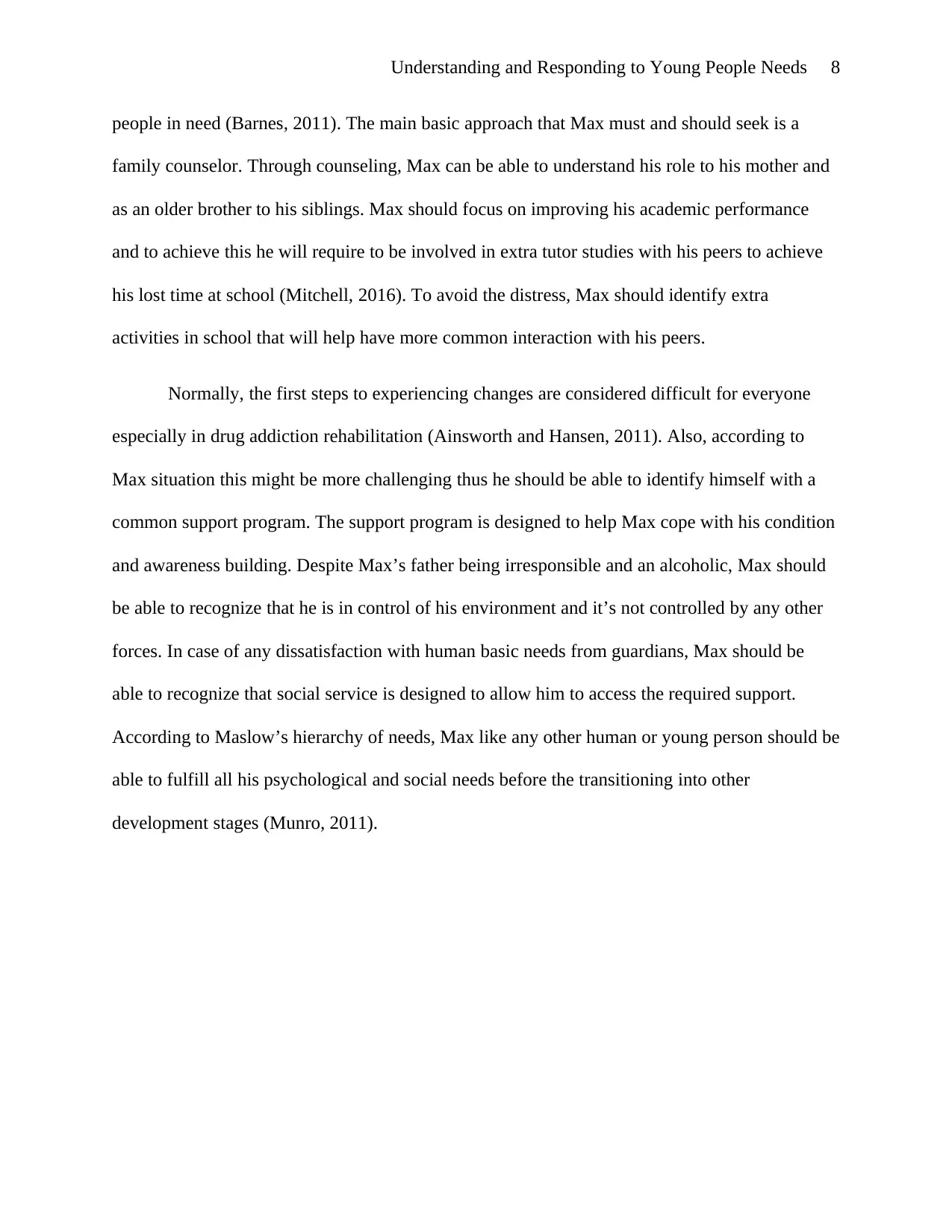
Understanding and Responding to Young People Needs 8
people in need (Barnes, 2011). The main basic approach that Max must and should seek is a
family counselor. Through counseling, Max can be able to understand his role to his mother and
as an older brother to his siblings. Max should focus on improving his academic performance
and to achieve this he will require to be involved in extra tutor studies with his peers to achieve
his lost time at school (Mitchell, 2016). To avoid the distress, Max should identify extra
activities in school that will help have more common interaction with his peers.
Normally, the first steps to experiencing changes are considered difficult for everyone
especially in drug addiction rehabilitation (Ainsworth and Hansen, 2011). Also, according to
Max situation this might be more challenging thus he should be able to identify himself with a
common support program. The support program is designed to help Max cope with his condition
and awareness building. Despite Max’s father being irresponsible and an alcoholic, Max should
be able to recognize that he is in control of his environment and it’s not controlled by any other
forces. In case of any dissatisfaction with human basic needs from guardians, Max should be
able to recognize that social service is designed to allow him to access the required support.
According to Maslow’s hierarchy of needs, Max like any other human or young person should be
able to fulfill all his psychological and social needs before the transitioning into other
development stages (Munro, 2011).
people in need (Barnes, 2011). The main basic approach that Max must and should seek is a
family counselor. Through counseling, Max can be able to understand his role to his mother and
as an older brother to his siblings. Max should focus on improving his academic performance
and to achieve this he will require to be involved in extra tutor studies with his peers to achieve
his lost time at school (Mitchell, 2016). To avoid the distress, Max should identify extra
activities in school that will help have more common interaction with his peers.
Normally, the first steps to experiencing changes are considered difficult for everyone
especially in drug addiction rehabilitation (Ainsworth and Hansen, 2011). Also, according to
Max situation this might be more challenging thus he should be able to identify himself with a
common support program. The support program is designed to help Max cope with his condition
and awareness building. Despite Max’s father being irresponsible and an alcoholic, Max should
be able to recognize that he is in control of his environment and it’s not controlled by any other
forces. In case of any dissatisfaction with human basic needs from guardians, Max should be
able to recognize that social service is designed to allow him to access the required support.
According to Maslow’s hierarchy of needs, Max like any other human or young person should be
able to fulfill all his psychological and social needs before the transitioning into other
development stages (Munro, 2011).
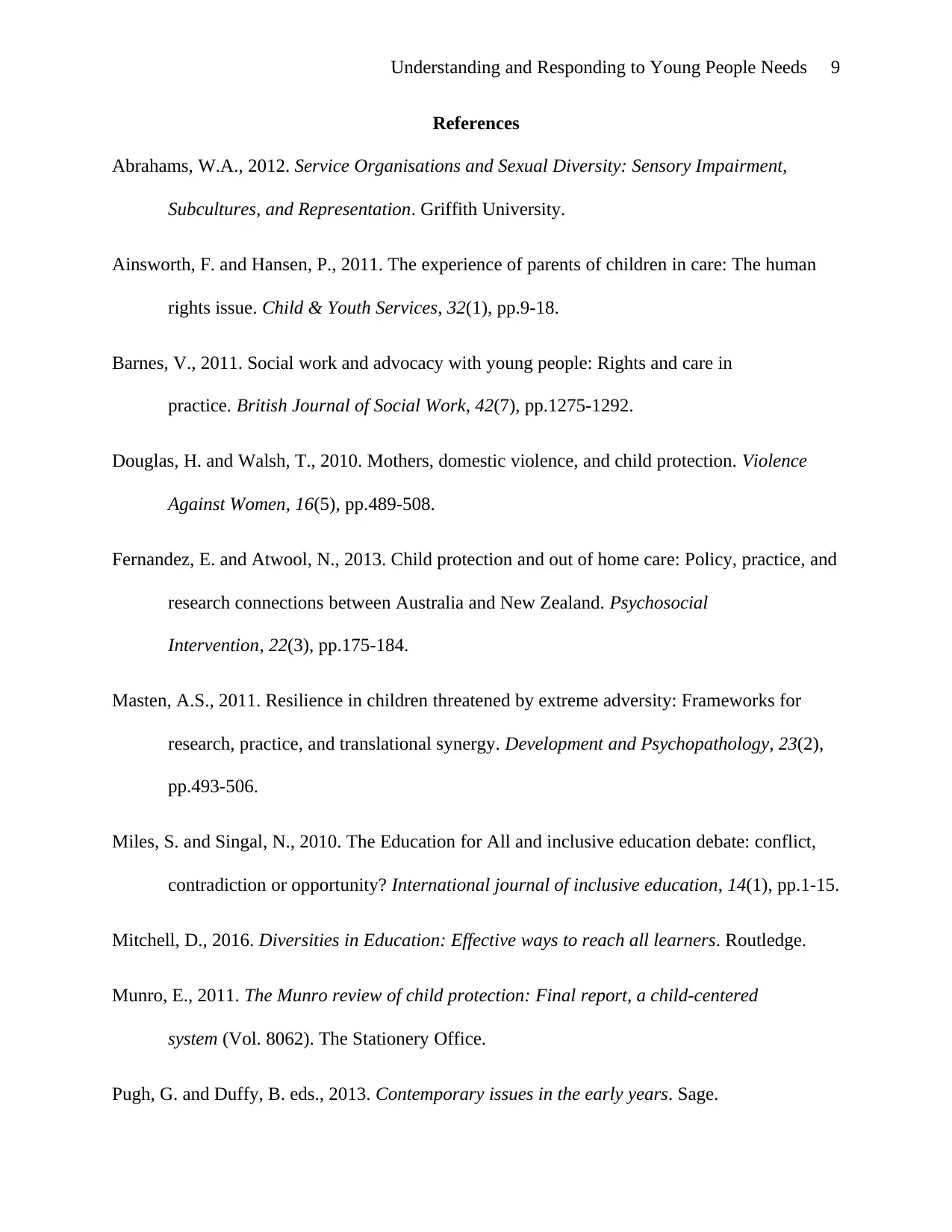
Understanding and Responding to Young People Needs 9
References
Abrahams, W.A., 2012. Service Organisations and Sexual Diversity: Sensory Impairment,
Subcultures, and Representation. Griffith University.
Ainsworth, F. and Hansen, P., 2011. The experience of parents of children in care: The human
rights issue. Child & Youth Services, 32(1), pp.9-18.
Barnes, V., 2011. Social work and advocacy with young people: Rights and care in
practice. British Journal of Social Work, 42(7), pp.1275-1292.
Douglas, H. and Walsh, T., 2010. Mothers, domestic violence, and child protection. Violence
Against Women, 16(5), pp.489-508.
Fernandez, E. and Atwool, N., 2013. Child protection and out of home care: Policy, practice, and
research connections between Australia and New Zealand. Psychosocial
Intervention, 22(3), pp.175-184.
Masten, A.S., 2011. Resilience in children threatened by extreme adversity: Frameworks for
research, practice, and translational synergy. Development and Psychopathology, 23(2),
pp.493-506.
Miles, S. and Singal, N., 2010. The Education for All and inclusive education debate: conflict,
contradiction or opportunity? International journal of inclusive education, 14(1), pp.1-15.
Mitchell, D., 2016. Diversities in Education: Effective ways to reach all learners. Routledge.
Munro, E., 2011. The Munro review of child protection: Final report, a child-centered
system (Vol. 8062). The Stationery Office.
Pugh, G. and Duffy, B. eds., 2013. Contemporary issues in the early years. Sage.
References
Abrahams, W.A., 2012. Service Organisations and Sexual Diversity: Sensory Impairment,
Subcultures, and Representation. Griffith University.
Ainsworth, F. and Hansen, P., 2011. The experience of parents of children in care: The human
rights issue. Child & Youth Services, 32(1), pp.9-18.
Barnes, V., 2011. Social work and advocacy with young people: Rights and care in
practice. British Journal of Social Work, 42(7), pp.1275-1292.
Douglas, H. and Walsh, T., 2010. Mothers, domestic violence, and child protection. Violence
Against Women, 16(5), pp.489-508.
Fernandez, E. and Atwool, N., 2013. Child protection and out of home care: Policy, practice, and
research connections between Australia and New Zealand. Psychosocial
Intervention, 22(3), pp.175-184.
Masten, A.S., 2011. Resilience in children threatened by extreme adversity: Frameworks for
research, practice, and translational synergy. Development and Psychopathology, 23(2),
pp.493-506.
Miles, S. and Singal, N., 2010. The Education for All and inclusive education debate: conflict,
contradiction or opportunity? International journal of inclusive education, 14(1), pp.1-15.
Mitchell, D., 2016. Diversities in Education: Effective ways to reach all learners. Routledge.
Munro, E., 2011. The Munro review of child protection: Final report, a child-centered
system (Vol. 8062). The Stationery Office.
Pugh, G. and Duffy, B. eds., 2013. Contemporary issues in the early years. Sage.
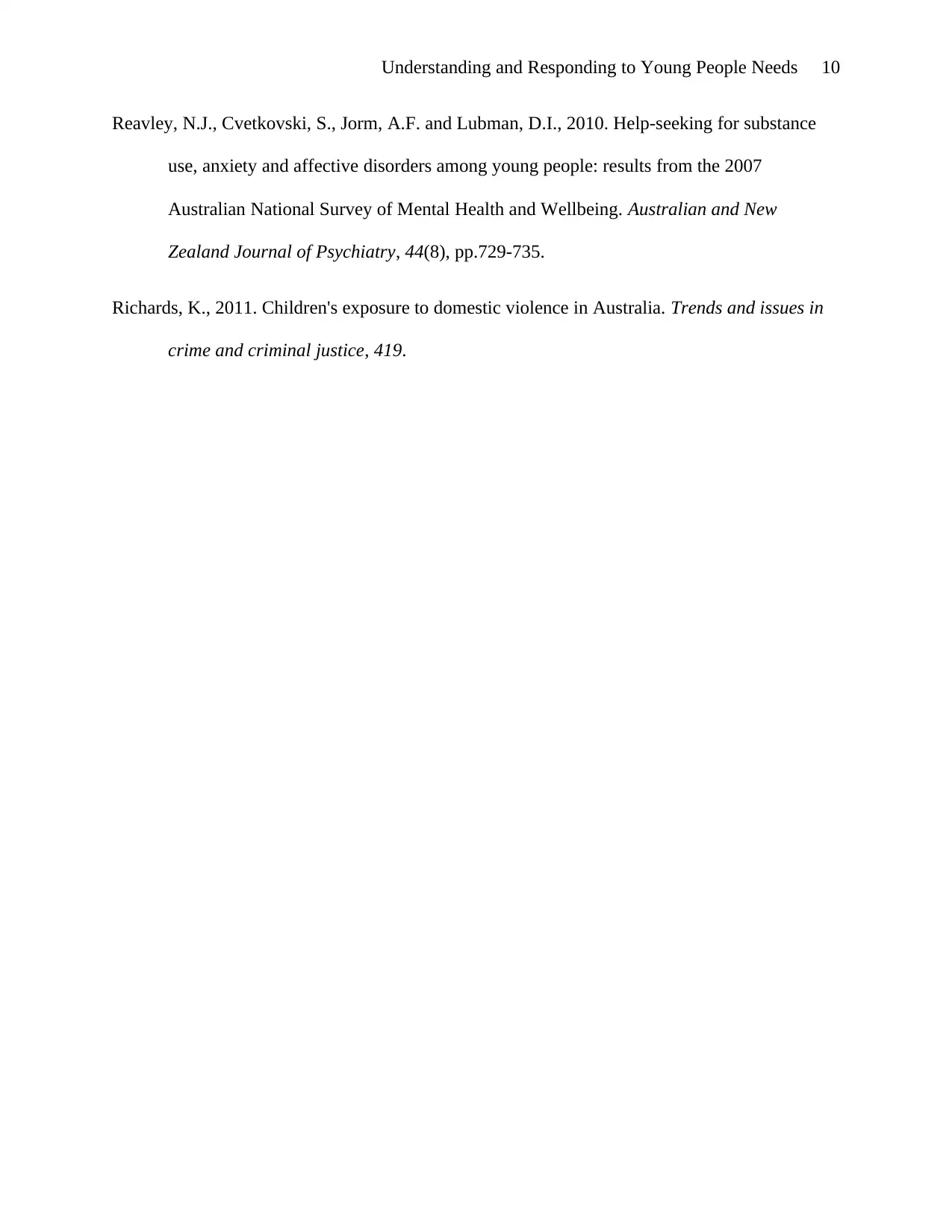
Understanding and Responding to Young People Needs 10
Reavley, N.J., Cvetkovski, S., Jorm, A.F. and Lubman, D.I., 2010. Help-seeking for substance
use, anxiety and affective disorders among young people: results from the 2007
Australian National Survey of Mental Health and Wellbeing. Australian and New
Zealand Journal of Psychiatry, 44(8), pp.729-735.
Richards, K., 2011. Children's exposure to domestic violence in Australia. Trends and issues in
crime and criminal justice, 419.
Reavley, N.J., Cvetkovski, S., Jorm, A.F. and Lubman, D.I., 2010. Help-seeking for substance
use, anxiety and affective disorders among young people: results from the 2007
Australian National Survey of Mental Health and Wellbeing. Australian and New
Zealand Journal of Psychiatry, 44(8), pp.729-735.
Richards, K., 2011. Children's exposure to domestic violence in Australia. Trends and issues in
crime and criminal justice, 419.
1 out of 10
Your All-in-One AI-Powered Toolkit for Academic Success.
+13062052269
info@desklib.com
Available 24*7 on WhatsApp / Email
![[object Object]](/_next/static/media/star-bottom.7253800d.svg)
Unlock your academic potential
© 2024 | Zucol Services PVT LTD | All rights reserved.